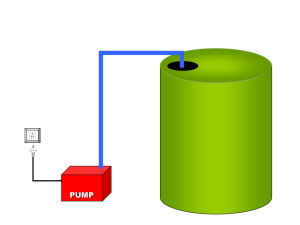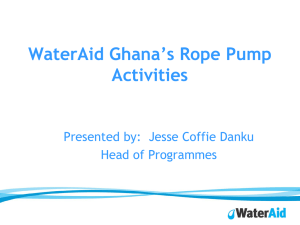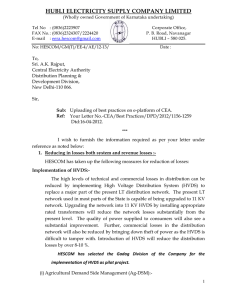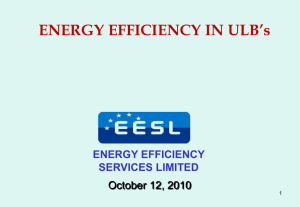WENEXA-corrected
advertisement
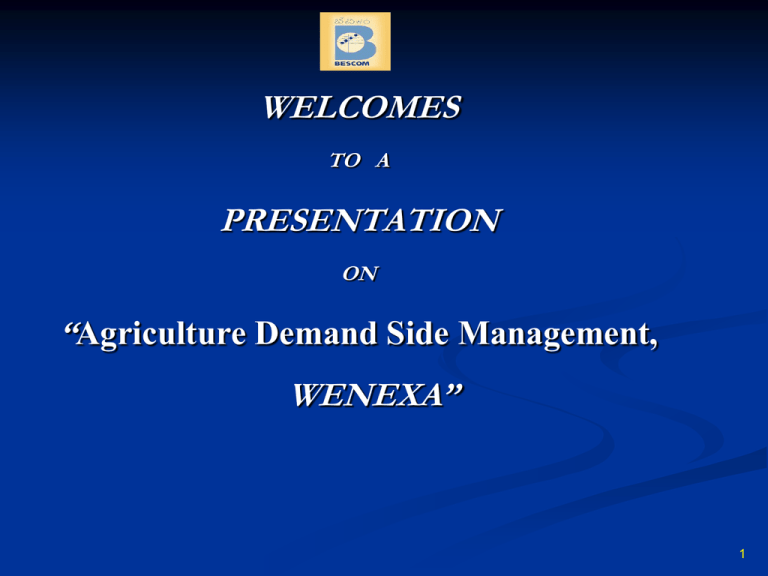
WELCOMES TO A PRESENTATION ON “Agriculture Demand Side Management, WENEXA” 1 Agriculture Demand Side Management, WENEXA • The State Agricultural consumption is about 25-30% out of total energy consumption. • The underground water potential is getting depleted faster using high cost of electrical energy. • When both underground water and electrical energy became scarce the necessity of conservation of energy to begin will became imminent. 2 Agriculture Demand Side Management, WENEXA Wenexa at Doddaballapur: • M/s ENZEN Global Solutions, an ESCO is engaged for replacement of existing IP sets in Doddaballapura on 11 KV feeders under USAID – WENEXA as Pilot (PPP Model). This ESCO Agriculture Demand Side Management model was designed in association with USAID-PA Consulting. • This pilot is the first of its kind in India to undertake Agriculture Demand Side Management under ESCO model. 3 Agriculture Demand Side Management, WENEXA The details of the project are: Geographical area No. of villages Population covered % of sown area % of irrigated area Major crops in the area Depth of ground water No. of feeders No. of pump sets surveyed No. of old pump sets replaced : : : : : : : : : : 11000 acres 34 17000 75% 16% mulberry and grapes 400 to 750 feet 4 no.s of 11 kV feeders 604 280 : 25-30% by New High Energy Efficient Pump sets Overall Energy Savings 4 Agriculture Demand Side Management, WENEXA • Proposed project: Option I: Doddaballapura Model: Here all the proposed IP sets under WENEXA Project have to be first got metered and base line studied and fixed by the agency taking up the work. This would take at least 12 months for the detailed survey, prepare project report and fix base line the metering of IP sets may cause delays as the farmers have to be convinced for metering of IP Sets. Option II: HESCOM Model: HESCOM have gone in for WENEXA project survey and preparation of project report through M/s. EESL A Central Government organization based on assessment HP connected of the IP Set rather than metering of each IP Set as in Doddaballapur case. 5 Agriculture Demand Side Management, WENEXA Approval from State Government has to be obtained for carryimg out this survey work through EESL a GOI undertaking. M/s EESL have carried out this survey work+ DPR at HESCOM at a cost of Rs.52.7 Lakhs for 11,000 IP seta in 2 Taluks. The survey report and DPR to be furnished by M/s. EESL, New Delhi in 6 months from the Date of Award. Here, only 10% of IP sets are proposed have to be audited for assessment of base line. This may not reflect the actual base line measurements and may lead to disputes later on while implementing the scheme. Agriculture Demand Side Management, WENEXA Option III: Modified HESCOM model: We may go in for HESCOM model with improvements in the conditions stipulated for IP sets that at least 25% of IP sets have to be taken up for detailed audit instead of 10% made by HESCOM. This would be a better proposal and may be considered for adoption. But this would entail additional cost and the cost of survey, Energy Audit and DPR may work out to Rs.1.32 crores for 11,561 IP sets covering 4 taluks and 9 substations. The method to be adopted for implementation of WENEXA Phase – II in BESCOM is placed in the ORM for a decision: a. Doddaballapura Model. b. HESCOM Model. c. Modified HESCOM Model. 7 Agriculture Demand Side Management, WENEXA Project Roll out: Phase-1: •Conducting initial survey and energy audit of the feeders with respect to Irrigation pump sets for implementation of AgDSM and furnishing a report. Phase-2: •Preparation of DPR to enable tender process. •Spreading awareness campaigns amongst all stake holders. •To etch out a business plan/model conducive for the project. •To etch out risk mitigation measures. Phase-3: Implementation AgDSM plan. 8 Agriculture Demand Side Management, WENEXA Scope of work: Phase-1 The objective of this assignment is to conduct detailed survey and Energy Audit of Agricultural Demand Side Management (AgDSM) scheme for 4 locations (taluks), 20 Nos. of feeders covering 9 substations, about 197 villages and 11,561 authorized IP sets in both the Bangalore Rural Area and Chitradurga Zones covering 2 circles each per zone. Provide an overview of existing facilities and current operating system. Conduct a survey to collect detailed information about all the agricultural consumers connected to these feeders. Water requirements/consumption, agriculture details, underground water level information and power supply pattern. Carry out a detailed energy audit (performance evaluation). Evaluate operating efficiency of all the pumps. Based on the field studies, evaluate the pump performance and efficiency of pumping systems. Furnish MIS/Final report based on the Energy audit and the field survey for preparation of DPR for the AgDSM project. 9 Agriculture Demand Side Management, WENEXA Phase – II The objective of this phase-II is to study the survey and MIS data furnished in the phase 1. To determine the capacity and type of new energy efficient pump to be replaced for the existing pumps for the same discharge. Quantify the extent of energy savings / performance improvement. Recommend various technically sound and economically viable measures. Provide a detailed estimate of the costs associated with the implementation of each of the proposed energy conservation measure in the report including break down for labour, materials and equipments. Preparation of DPR and RFP for the tendering of the implementation of the AgDSM programme as part of Phase-III activities. Tender notification and validation to identify the agency for the project. 10 Agriculture Demand Side Management, WENEXA Phase-3: No Cost to BESCOM to Implement. To enable the awardee to clearly satisfy the data, begin the implementation process of replacement of Energy Efficient Pump sets of appropriate capacity and to showcase the Energy savings so obtained after replacing old Pump sets. Energy savings calculation: Total Energy Savings = (Power (kW) consumed by the old pumps – power (kW) consumed by new pump) x no. of actual hours of operation received from substation (minimum 6 hrs per day or whichever is higher). The quantified energy savings shall be accounted in rupees by considering the PPPP (Power Pool Purchase Price). The successful vendor (agency) will raise invoice in the name of BESCOM for every month and will realize the payment through an ESCROW mechanism. 11 Agriculture Demand Side Management, WENEXA Estimated Budget : 25% of the total IP sets: Detailed audit including water flow and others as mentioned in Phase-1 (scope of work). 2890 IP sets x 1600 = Rs.46,24,400/75% of the total IP sets: Detailed audit excluding water flow measurement, connected load. 8670 IP sets x 600 = Rs.52,02,000/Total = Rs.98,26,400+(service tax 12.36% Rs. 12,14,54,304) = Rs.1.32 Crores 12 Comparative statement of two AgDSM models Parameters BESCOM- Doddaballapur method BEE / EESL / HESCOM method Locations of implementation Doddaballapur Hubli area HVDS system Yes No Digital meters Yes No Energy savings calculation Based on data collected from meters Based on the energy saved with reference to the capacity of the replaced pump sets Meter Data collection Monthly No Estimation of pump set efficiency over the years Indirect way through meters Every year connected load is calculated and accordingly energy savings will be calculated Parameters BESCOM- Doddaballapur method BEE / EESL / HESCOM method Advantages • Reliable method of energy saving calculation • Farmers are getting good quality power supply • Very fast implementation of the programme • Less capital cost / no operational cost to utility (no HVDS and metering / no meter burning) . Limitations • Installation of HVDS is time consuming affair • Installation of meters is practically a difficult task and highly time demanding (due to resistance from farmers) • Minimum time required to start installation of efficient pump sets – 2 years (first year – HVDS and metering, second year – baseline data collection) • High operational cost due to burnt meters (about 10%-15% defective meters every year. • Because of absence of HVDS , pump sets burning chances are more. (This can be addressed by inclusion of such costs in the project) in phase – IIII. THANK YOU 15

